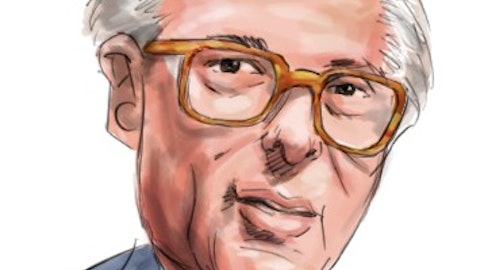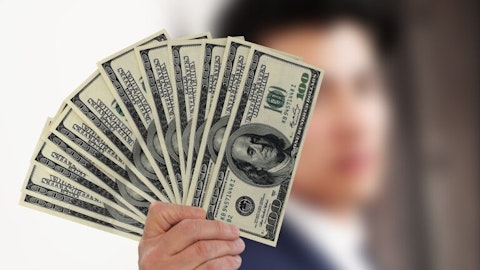East 72, an investment management firm, published its first quarter 2021 investor letter – a copy of which can be downloaded here. A quarterly portfolio return of 9.1% was recorded by the fund for the Q1 of 2021. Over the year to March 31, 2021, East 72 returned 42.7% before expenses, despite an average net equity exposure of only 28%. You can view the fund’s top 5 holdings to have a peek at their top bets for 2021.
East 72, in their Q1 2021 investor letter, mentioned Valhi, Inc. (NYSE: VHI) and shared their insights on the company. Valhi, Inc. is a Dallas, Texas-based chemicals company that currently has a $638.6 million market capitalization. Since the beginning of the year, VHI delivered a 48.62% return, impressively extending its 12-month gains to 74.31%. As of April 09, 2021, the stock closed at $22.59 per share.
Here is what East 72 has to say about Valhi, Inc. in their Q1 2021 investor letter:
“Many value based investors will be familiar with the concept of “trading the discount” – a not uncommon situation in listed investment companies, where there are often constraints such as restrictive management contracts – which may prevent full realisation. Hence, buying at (say) a 40% discount to NTA and selling at 15% is a reasonable strategy which would yield a 42% return plus/minus dividends and movements in NTA.
To some degree, this is Valhi (NYSE: VHI) – one of the most intriguing companies we have analysed in some years. It is utterly controlled by the Simmons family based in Dallas, TX – they control 92% of the equity (87.4% directly and 4.5% via Treasury stock held in two subsidiaries), provide a US$320million debt facility (drawn to $271mn) to this parent entity and have a tax
sharing facility with VHI. But VHI sits atop a four listed company structure (plus controlling interests in two relevant subsidiaries), which might have been pieced together almost anarchically, but now has a logical structure which is unlikely to be collapsed in the near future.So Vahli has a free float of only around 2.4million shares (priced at ~US$54million) of which the famous Renaissance Technologies owns around 7%.
This is a real outlier. Contran is a private company control of which was bequeathed in 2014 to two of his daughters by Harold Simmons, a Dallas based businessman, political activist, philanthropist and keen tax planner. Why only two of his four daughters? The other two challenged his trust structure in court in 19974 and settled out of court in 1998 for US$50million
each.This left the corporate structure to the two remaining daughters, one of whom, Serena, unfortunately died in April 2020. Control is therefore strongly vested in the other daughter, Lisa Simmons, together with Serena’s husband.
Vahli is close to the ultimate conceptual “this MUST be mispriced” equity I have ever come across, since within the four company structure, it has:
• Insignificant free float, family control and family credit supply;
• Ownership by two listed subsidiaries (NL & in a small way Kronos) of parent company stock;
• Operates across four industries: titanium dioxide (Kronos), locking devices, recreational marine accessories (CompX) and a master planned community development in Henderson, Nevada6 (BMI, but land held by Landwell);
• Joint venture with a competitor (Kronos 50% holding of Louisiana Pigment LP with a major competitor Venator);
• Environmental remediation liabilities relating to a prior activity of manufacturing lead pigment for paint (NL);
• Litigation liabilities related to lead-based paint (NL) based on one successful case7; and
• Pension fund shortfalls (Kronos).How did it get like this?
The current structure really emanates from the residue of Harold Simmons corporate career, which started in his late twenties, focused initially around the drugstore industry; from 1973 onwards, he began to invest actively in listed securities, being prepared to acquire control, and with a focus on maximising shareholder value. Contran effectively acquired control of Vahli in
1979, but has engineered a series of acquisitions and disposals across industries such as insurance and waste management.Titanium dioxide
It is clear from the initial flow chart and table that the key “value” within Vahli lies with Kronos Worldwide, where the group owns 80% of this titanium dioxide producer which was spun off in 2003-2005 (50% VHI; 30% NL).
Kronos is the fifth largest global manufacturer of titanium dioxide (TiO2) with around 7% of global sales where the top five players hold ~52% market share of a 7.4million tonne industry; based on prevailing prices, the global industry has production valued at ~US$23billion.
TiO2 has multiple uses as a whitening pigment in coatings (paint), plastics, paper, cosmetics etc; coatings are generally ~60% of end use. KRO has six plants of which four are in Europe (one USA and one Canada) which gives the company a bias to the German market, where it is the largest player. 66% of production is at the four European plants.
Kronos trades at a middle rank to the other producers, in our opinion partly attributable to the thin float, but also the low debt load, and consistent margins over recent years:
The TiO2 demand environment seems to be improving – sharply. Tronox noted in their 2020 results presentation8 that they expected sequential sales volumes of TiO2 to increase 11-15% in Q1 2021 with an implication of some price increases in the $100/tonne area (3%). Venator also noted demand recovery and price/margin improvement likely in their near term outlook.
As a guide, Kronos should be capable of earning a minimum $192million EBITDA (before pension costs) at sales levels of 530,000 tonnes of TiO2 at prices around $3,100 a tonne and 22.5% gross margin. Past peak earnings occurred in 2011 with an average selling price above $3,860/tonne.
Realising value from the corporate structure?
It is highly unlikely that the corporate structure will be collapsed into a single company. This does NOT mean that the Simmons family are poor capital managers or antagonistic towards minority shareholders; indeed, it’s arguably the opposite.
In August 2020, the family CANCELLED WITHOUT PAYMENT, US$600million worth of preference shares which had previously been issued in March 2007 to deal with a taxation settlement across the group. Hence, there was an instant $600m uplift in equity value to common shareholders (admittedly, the Simmons family are ~ 92% of that).
Secondly, the corporate structure acts as a benefit to Vahli, with NL acting as a “corporate shield” keeping potentially adverse legal judgements and payments away from the parent in an effective “non-recourse” style structure.
The innocuous initials “NL” hide past activities – they once stood for “National Lead” and manufactured lead pigments which went into paint. This leaves two potential areas of difficulty: potential liability for the impact of consumers handling articles coated with paint incorporating lead based pigment, and the potential environmental issues at previous plant locations. NL has significant cash, and a dividend paying 30% stake in Kronos as well as control of CompX.
However, it has on-balance sheet liabilities for environmental remediation of ~$93million plus litigation settlement reserves of $61million, relating to the sole settled judgement against the company.
Whatever NL’s directors views – and the wording in relation to these matters in all the relevant 10-K’s is VERY tight – the equity market takes a different view; NL shares trade at an approximate 45% discount to NTA when the CompX stake is deconsolidated and replaced at market value (~1.6x BV) which has gained significantly in the past month.
There are possibilities of NL distributing some of its assets down the track, especially noting the environmental liability figures have barely moved in the past three years, but that can’t figure as a core tenet for this argument.
Hidden asset emerging: Henderson, Nevada
Henderson is around 20minutes drive south-east of the Las Vegas Strip and half an hour west of the Hoover Dam. VHI, through two majority owned subsidiaries, BMI and Landwell, supply water utility to parts of the city (BMI) and owned 2,100 acres of residential development site (plus 100 acres of other development land) predominantly to the NW of town.
The land comes from the location of old magnesium manufacturing plants, closed down after WWII, and remediated over a twenty year period. Thanks to the bankruptcy of Tronox, one of the other owners, in 2013, Vahli moved to controlling the two relevant companies. Over the seven subsequent years, Landwell has sold off 1,000 of the 2,100 acres to builders and others at
an average price over the whole period of around US$250,000 per acre. Due to past accounting, the acreage sales do not yield profit, but cash.Based on the 2014 transaction value of BMI ($40m for 100%) and our assessment of cash flow production from land sales over a ten year future period discounted at 10%, giving an estimated value of $160m for 100% of Landwell, we believe VHI’s stake in the two companies to be worth ~ US$119million or $4.20/VHI share. This aspect of Valhi’s valuation has been brought into focus by a large sale of ~220acres for $55million in the final quarter of 2020 (likely to builder D.R. Horton).
What is Vahli potentially worth at the present time?
Vahli has appreciated sharply since our purchases, and at end March, we are around 41% ahead on our entry price. There are a myriad of catalysts for further re-rating ranging from the TiO2 market to further Nevada land sales, let alone any unexpected corporate re-organisation and buyback.
In our tabular analysis (link, Page 10), which is composed on a “see-through” basis, at its end March 2021 price of $20.51 per share, Vahli trades at a 54% discount to our assessed NAV of $44.50/share.
It should be noted that the NL share price at $7.45 trades at a 45% discount to its NTA after deconsolidating CompX; if we were to substitute this into the table below and remove the seethrough values of Kronos and Compx, Vahli would still have an assessed NAV of $35.92 a share, leaving the shares at a mere 43% discount!”

Copyright: dolgachov / 123RF Stock Photo
Our calculations show that Valhi, Inc. (NYSE: VHI) does not belong in our list of the 30 Most Popular Stocks Among Hedge Funds. As of the end of the fourth quarter of 2020, Valhi, Inc. was in 4 hedge fund portfolios, compared to 3 funds in the third quarter. VHI delivered a 32.11% return in the past 3 months.
The top 10 stocks among hedge funds returned 231.2% between 2015 and 2020, and outperformed the S&P 500 Index ETFs by more than 126 percentage points. We know it sounds unbelievable. You have been dismissing our articles about top hedge fund stocks mostly because you were fed biased information by other media outlets about hedge funds’ poor performance. You could have doubled the size of your nest egg by investing in the top hedge fund stocks instead of dumb S&P 500 ETFs. Here you can watch our video about the top 5 hedge fund stocks right now. All of these stocks had positive returns in 2020.
At Insider Monkey, we scour multiple sources to uncover the next great investment idea. For example, Federal Reserve has been creating trillions of dollars electronically to keep the interest rates near zero. We believe this will lead to inflation and boost real estate prices. So, we recommended this real estate stock to our monthly premium newsletter subscribers. We go through lists like the 15 best innovative stocks to buy to pick the next Tesla that will deliver a 10x return. Even though we recommend positions in only a tiny fraction of the companies we analyze, we check out as many stocks as we can. We read hedge fund investor letters and listen to stock pitches at hedge fund conferences. You can subscribe to our free daily newsletter on our website:
Disclosure: None. This article is originally published at Insider Monkey.


